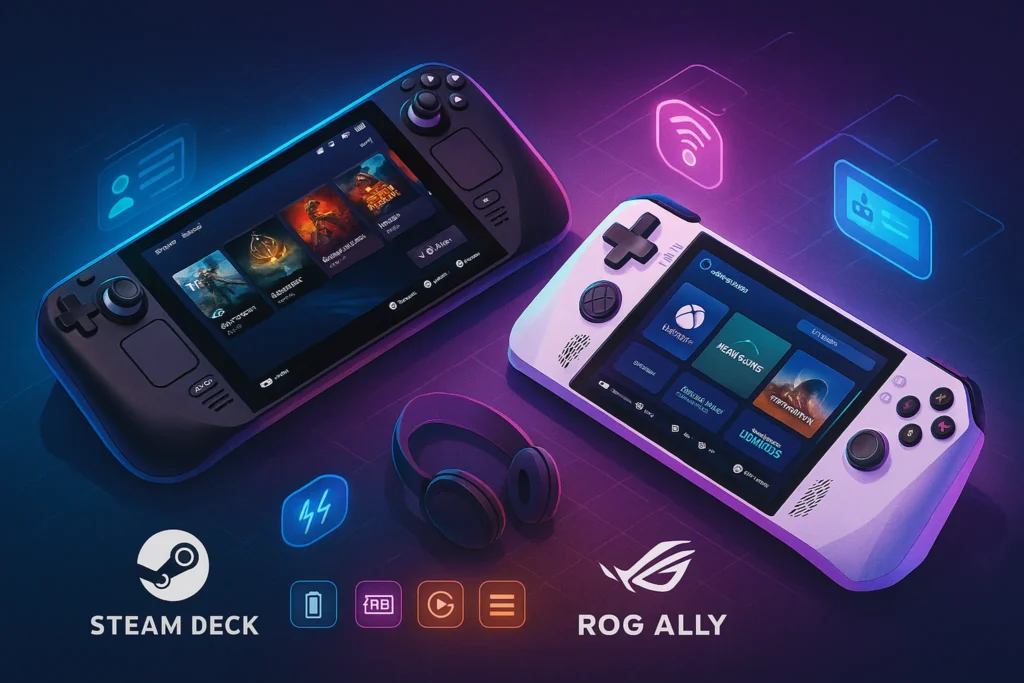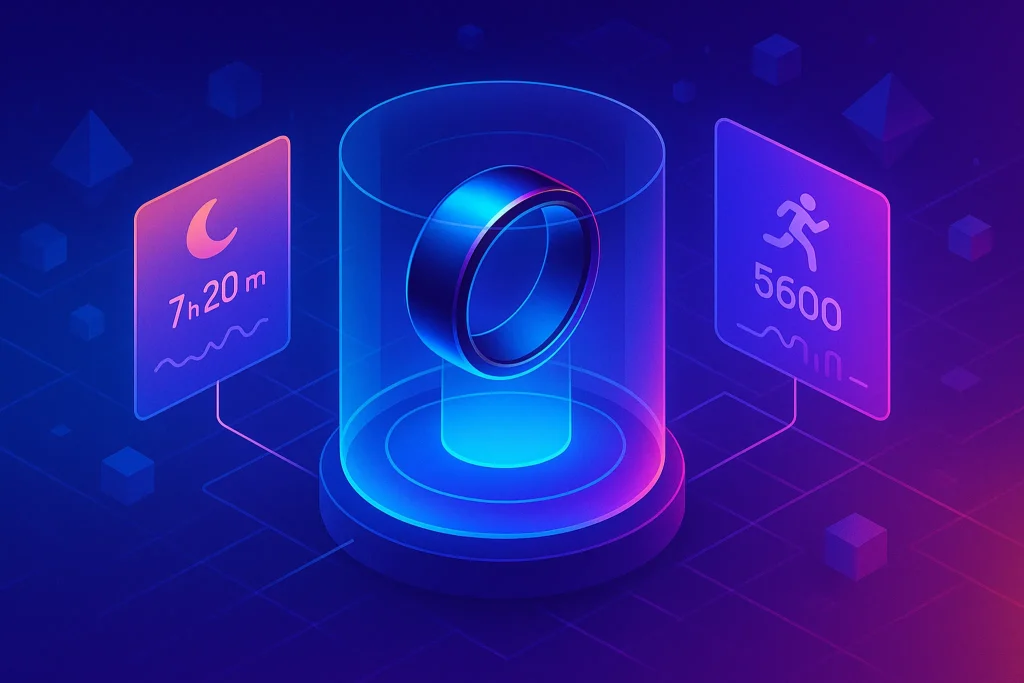-This post may contain affiliate links. If you click on one and make a purchase, I may earn a small commission at no extra cost to you.-
🧠 Introduction
Handheld PC gaming is thriving in 2025—but when it comes to choosing between Valve’s Steam Deck and ASUS’s ROG Ally, which one truly fits your style? In this comparison, we’ll dive into each device’s hardware, software, battery life, ergonomics, and gaming ecosystem to help you pick your ideal portable powerhouse.
🎮 1. Design & Ergonomics
Steam Deck
-
Grip & Button Layout: The textured grips and asymmetrical layout (thumbsticks + trackpads) give a balanced feel suitable for long sessions. Many users report improved control precision, especially in RTS or simulation games. Some ergonomics professionals note the trackpad acts as a makeshift mouse—ideal for performance-heavy PC titles like Civilization VI.
-
Material Choices: Valve uses anodized aluminum accents with a matte plastic shell. This keeps the handheld sturdy, but some users report the surface accumulates finger oils over time. Cleaning with a microfiber cloth and gentle isopropyl alcohol works well.
-
Audio & Haptics: Dual “stereo wavetables” speakers and dual haptic vibration motors produce crisp sound and feedback. While not studio-grade, it’s enough for casual play when you’re away from headphones.
- features a sturdy build, textured grips, trackpads, and symmetric controls—engineered for comfort during long play sessions. Despite its weight (~669 g), its balance is praised.
ROG Ally
-
Form Factor: At 608g, ROG Ally is noticeably lighter, with aggressive side grips and tactile buttons drawn from ROG controllers. The layout is closer to console ergonomics, making it intuitive for console gamers.
-
Build Quality: High-quality molding and minimal creaking. However, under heavy thermal load, some users report minor flex near the cooling vents.
-
Triggers & Controls: Beefier shoulder buttons and responsive triggers provide a more console-like feel, though some find the triggers stiff for long use—likely due to rain-proofing mechanics.
- lighter (~608 g) and more compact, boasts high-friction shells but triggers reportedly feel stiff. It’s more streamlined but trades some grip for speed.
Pro Tip: Prefer comfortable form factor? Steam Deck’s ergonomic design scales better in handheld mode.
⌨️ 2. Software Ecosystem & Interface
Steam Deck
-
SteamOS Navigation: The Deck UI emphasizes big visuals and easy discovery. Steam Curator lists, controller-friendly animations, and game overlays embed seamlessly.
-
Proton Support: Valve’s Proton translation layer runs 90%+ of AAA Windows launches out of the box. Community-enabled tweaks maximize performance for titles like Red Dead Redemption 2.
-
Modding Community: Deck players enjoy custom UI themes, performance overlays, and fan GUI tweaks like “ARK” or “Power Tools”.
- runs SteamOS 3 with full Steam library integration and Proton layer for Windows-only titles. It offers intuitive UI, quick suspension, and native deck controls.
ROG Ally
-
Windows Experience: Full desktop capabilities with Steam, Epic, Xbox, GOG—all accessible. ROG software adds performance modes (Silent, Performance, Turbo) directly into Game Center UI.
-
Cloud Services: With Xbox Game Pass and Wi-Fi 7 support, cloud gaming runs at 1080p/120 fps—handling intensive games like Forza Horizon 5 smoothly.
-
Driver Support: Realtek HDMI/DisplayLink compatibility allows use with multiple docks or screens without disconnection hassles.
- with Windows 11, delivers desktop flexibility—install any Windows app or launch Xbox Game Pass, but may lack handheld UI polish. Proton-based streaming requires tweaking.
⚙️ 3. Performance & Game Compatibility
-
Benchmarks:
-
Cyberpunk 2077: ROG Ally averages 50–60 FPS on medium/high; Deck hits 40–50 FPS at medium settings.
-
Doom Eternal: 120 FPS on ROG with framerate unlocked vs ~90 FPS on Deck at 720p maxed.
-
-
Optimum Settings Per Game:
-
Valve’s GearUp configs + Deck Verified overlay.
-
ASUS’s Game Center automatically toggles PL1/PL2 and dynamic charging based on FPS.
-
-
Compatibility Edge:
-
Some Windows-only titles like Valheim or Planet Zoo run natively on Ally. Deck needs Proton workarounds or misses SteamOS achievements.
-
-
CPUs: ROG Ally’s Ryzen Z1 Extreme handily outperforms Steam Deck’s Zen 2 in multitasking and demanding titles.
-
GPUs: RDNA 3 enables smoother high-res gaming, while Steam Deck’s RDNA 2 is constrained to 800p.
-
Thrashing Tests: Titles like Cyberpunk run at medium settings on ROG quite smoothly; Deck targets low-to-medium at 60 fps.
🔋 4. Battery Life & Thermal Control
Steam Deck
-
Efficiency First: Well-balanced CPU/GPU gives quieter fans and stable ~55°C under stress.
-
Battery Modes: Deck’s “Silent” limits clocks for up to 3.5 hours; “Turbo” drains battery in ~1.5 hours.
-
Battery Mods: Third-party 70 Wh batteries (sold separately) notably extend runtime by 40%.
- lasts ~3 hours under moderate use, with an effective hardware switch to manage thermals quietly.
ROG Ally
-
Thermal Headroom: With its twin-fan design, it sustains higher clocks longer—CPU/GPU temps hover in mid-70°C range.
-
Power Modes:
-
Silent: ~7W limit, 2.5 hours runtime.
-
Performance: 12–14W, ~1.8 hours.
-
Turbo: 20W+, runs nearly hot and barely 1 hour
- lasts around ~2 hours in gaming, but its larger fans keep temperatures lower under high FPS loads. It charges faster and can power USB-C peripherals effectively.
-
🧳 5. Portability & Build Quality
-
Steam Deck:
-
Includes a 45W USB-C PD adapter with 27W passthrough.
-
Optional Valve Dock provides HDMI 2.0 output, Ethernet, USB-A—a desktop fallback.
- is robust and replacement parts are community-friendly.
-
-
ROG Ally:
-
Supports high-power 65W USB-C adapters (Surface/PS5 compatibility).
-
Bonus: 2.5G Ethernet via Type-C hub; Bluetooth 5.3 handles keyboards/DRM audio pairing.
- feels high-end and pocketable, but claimed high component sensitivity to dust and heat—a concern for heavy gamers on the go.
-
💾 6. Storage, Expandability, & Boot Flexibility
-
Steam Deck:
-
Includes a full-size microSD slot supporting UHS-I (up to 100 MB/s). Install games on microSD for larger libraries.
-
Valve is rolling out tooling support for dual-boot setups—letting power users switch between SteamOS and Windows while preserving installations.
-
-
ROG Ally:
-
Offers NVMe upgradeability—unscrew the bottom panel to access the SSD. Users praise this for speed and flexibility.
-
Supports external USB-A SSDs behind the device, ideal for content creation or media-heavy games.
-
💰 7. Price & Value
Include links to current pricing (USD/Euro).
-
Steam Deck 512 GB: $549 MSRP—currently discounted to ~$499 on sale.
-
ROG Ally (Z1 Extreme): $699 MSRP; regularly bundled with free Game Pass 12-month license and $100 ASUS credit.
Steam Deck (512 GB model) is about $549, while ROG Ally retails at around $699. The extra $150 unlocks Windows capability, faster CPU/GPU, and higher-res display.
🧠 8. User Experience & Interface Deep Dive
SteamOS on Steam Deck
-
Optimized UI: SteamOS features a gamepad-first interface with seamless navigation, big visuals, and fluid animations. The Steam library integrates tightly, and features like “Deck Verified” help guide compatibility.
-
Touch & Trackpad Precision: The dual trackpads allow precise pointer control, acting as a mouse for games and desktop apps. This is a huge advantage for strategy games and emulators.
-
Quick Access Menu: Pressing the Steam button opens a rich overlay with battery status, CPU/GPU stats, thermal control, and performance tuning—all in-game without interrupting play.
Windows 11 on ROG Ally
-
Full Desktop Experience: The Ally offers a traditional Windows interface, supporting all PC launchers, game mods, Discord, OBS, and even Office tools.
-
Game Library Access: Users can run Steam, Xbox, Epic, GOG, Battle.net—basically anything. The flexibility is unmatched but requires more setup time.
-
ASUS Armoury Crate: A custom dashboard provides quick profile switching, fan control, and performance monitoring. It’s essential for smooth handheld use.
🎯 9. Who Should Buy Which?
| User Type | Recommended Device | Why It Fits Them |
|---|---|---|
| Steam-Only Gamers | Steam Deck | Seamless SteamOS integration, simple interface |
| Power Users | ROG Ally | Full Windows, modding, streaming, multitasking |
| Cloud Gamers | ROG Ally | Superior Xbox Cloud/GeForce Now support |
| On-the-Go Players | Steam Deck | Better battery, sturdy build, trackpad navigation |
| Tinkerers & Devs | Steam Deck | Dual-boot options, open-source community |
🛠️ 10. Customization, Mods & Accessories
Steam Deck
-
OS Mods: Run SteamOS, Windows, or custom Linux builds. Use tools like EmuDeck, PowerTools, or CryoUtilities for advanced tuning.
-
Hardware Add-ons: Replace thumbsticks, grips, or install Dbrand skins. Community docks enable dual display setups and charging.
-
Advanced Use: Install game mods, tweak GPU/CPU wattage, or apply Proton-GE for better compatibility.
ROG Ally
-
Windows Freedom: Install any PC app, tweak registry settings, and use advanced power plans for performance vs battery balance.
-
Armoury Crate Profiles: Create per-game fan and power profiles. Tweak RGB lighting and button mappings.
-
Accessory Ecosystem: Plug in USB hubs, external GPUs via XG Mobile, or display adapters. Excellent for hybrid gaming setups.
🧩 11. Multiplayer & Streaming Support
Remote Play / Steam Link
-
Steam Deck: Comes with built-in Steam Link; stream games from a desktop PC on LAN or over internet. Easy pairing with DualShock or Xbox controllers.
-
ROG Ally: Supports Steam Link via app but setup is manual. Still works well once configured.
Cloud Gaming
-
ROG Ally: Excellent support for Xbox Cloud Gaming, NVIDIA GeForce NOW, and Boosteroid—all running natively on Windows.
-
Steam Deck: Capable of cloud gaming via browser or flatpak apps, but compatibility is limited unless running Windows.
Multiplayer Setup
-
Steam Deck: Supports Bluetooth controllers and voice chat via Steam overlay. Discord works with flatpak, though not perfectly.
-
ROG Ally: Full Discord support with overlays, webcam access, and streaming tools. Easy multitasking between chat and gameplay.
Bonus:
For tips on creating a mobile gaming workstation with power banks and docks, check out our guide on The Ultimate Smart Home Setup Guide: Gadgets, Tips, and Tricks.
📊 Feature Comparison Table
| Feature | Steam Deck | ASUS ROG Ally |
|---|---|---|
| CPU / GPU | Custom AMD APU (Zen 2 + RDNA 2) | AMD Ryzen Z1 / Z1 Extreme (Zen 4 + RDNA 3) |
| RAM | 16 GB LPDDR5 | 16 GB LPDDR5 |
| Storage | 512 GB NVMe (microSD slot) | 512 GB NVMe + microSD slot |
| Display | 7″ LCD @ 800p | 7″ IPS @ 1080p, 120 Hz |
| OS | SteamOS 3 (Linux-based) | Windows 11 |
| Battery | ~2–3 hours typical gaming | ~1.5–2.5 hours |
| Ports | USB-C (Display/Power/Audio) | USB-C, USB-A, pennel, micro-HDMI |
| Price (512 GB) | ~$549 USD | ~$699 USD |
🧠 Nerd Verdict
-
Best for Steam gamers: Go for the Steam Deck—solid performance, excellent control scheme, and community mods.
-
Best for Windows flexibility: Choose the ROG Ally—great raw power and full desktop experience in a handheld form.
❓ FAQ
Q: Can the Steam Deck run Windows?
A: Yes it can, but requires user installation. Linux-optimized SteamOS gives better battery and stability by default.
Q: Which device is better for cloud gaming?
A: ROG Ally has a faster screen and Windows compatibility—but Steam Deck excels with Steam Link in handheld mode.
Q: What’s a key downside of ROG Ally?
A: It runs hotter and louder during demanding sessions due to Windows overhead.
💬 Would You Bite?
Which one would you choose—Steam Deck or ROG Ally for your gaming on the go?
Tell us your pick and why; we’re comparing notes below! 👇



